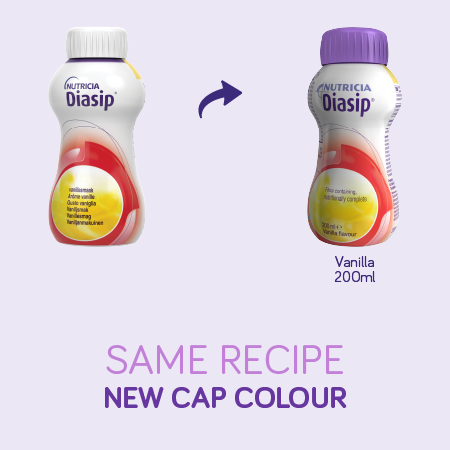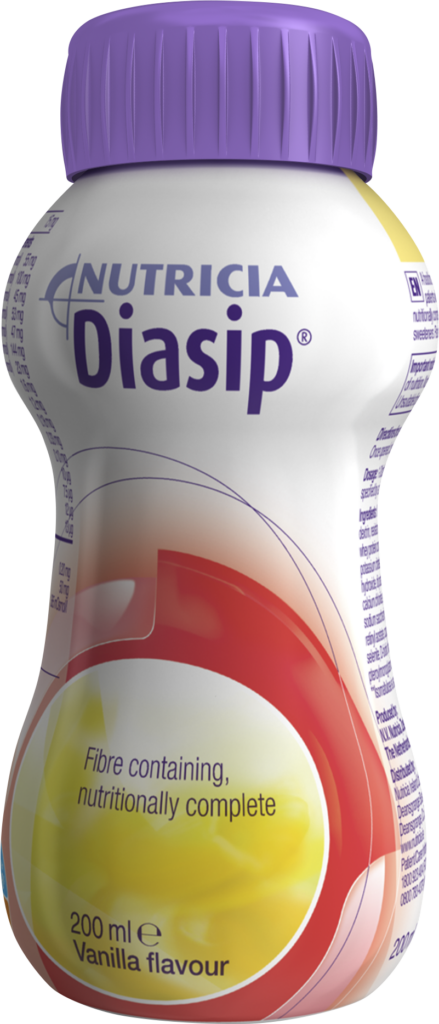

Product Information
A ready-to-drink, nutritionally complete, low glycaemic index oral nutritional supplement.
Link copied!
Indications
For the dietary management of disease related malnutrition in patients with diabetes mellitus, hyperglycaemia or impaired glucose tolerance.
Important Notice
- Not for parenteral use.
- Not suitable for patients with galactosaemia.
- Not suitable for patients with fructosaemia.
- Not suitable for patients requiring a fibre free diet.
- Not suitable for patients with cow’s milk protein allergy.
- Not suitable for infants and children under 3 years of age.
- Use with caution in children aged 3-6 years of age.
- Must be used under medical supervision.
Direction for Use
- Shake well before use.
- Best served chilled.
- Usage to be determined by a healthcare professional.
Storage
- Store in a cool, dry place.
- Once opened, close the bottle and store in a refrigerator.
- Discard unused content after 24 hours.
Order Information
Contact Nutricia Customer Experience 1800 889 480
| Diasip | Presentation | Product Code | Units per carton |
| Vanilla | 200ml bottle | 169349 | 24 |
Ingredients
Full ingredients list and nutritional information is available on the product fact sheet.
Allergen & Cultural Information
- Contains: milk, soy and fish.
- Halal certified.
- Nutricia UK and/or Ireland have Kosher approval for this product.
- No gluten containing ingredients. No detectable gluten when tested to a sensitivity level of less than 5 parts per million (<5 ppm i.e. <5mg/kg).
References
- Hofman Z, Rouws C, van Drunen JDE, Kuipers H. The effect of enteral nutrition on glucose and triglyceride concentrations during 6 hours continuous feeding in diabetic patients. Clin Nutr. 2004;23:1478-79.
- Kawai K, Yoshikawa H, Murayama Y, Yamashita K. Usefulness of palatinose as a caloric sweetener for diabetic patients. Horm Metab Res. 1989;21:338-40.
- Kawai K, Okuda Y, Yamashita K. Changes in blood glucose and insulin after an oral palatinose administration in normal subjects. Endocrinol Jpn. 1985;32:933-6.
- Severijnen C, van der Beek EM, Hageman R, van Laere K, Van de Heijning BJM. Amelioration of fasting plasma glucose levels in diabetic rats after two weeks on an aspartate-rich diet. 2007 25th International Symposium on Diabetes and Nutrition (DNSG).
- American Diabetes Association (ADA). Standards of medical care in diabetes. Diab. Care. 2006;29:4-73.
- DNSG: The Diabetes and Nutrition Study Group (DNSG) of the European Association for the Study of Diabetes (EASD), 1999. Recommendations for the nutritional management of patients with diabetes mellitus. Eur J Clin Nutr. 2000;54:353-355.
- National Health and Medical Research Council. Australian Dietary Guidelines. 2013. Canberra: National Health and Medical Research Council.
- Higgins JA. Resistant starch: metabolic effects and potential health benefits. J AOAC Int. 2004;87:761-8
Additional Information
^ In accordance with Australia New Zealand Food Standards Code – Standard 2.9.5.
Food for special medical purposes for use under medical supervision.
